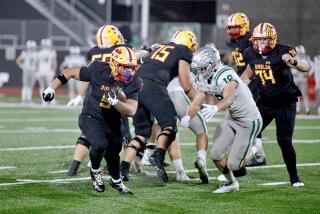Reputations, and sometimes even lives, on line in rivalries
- Share via
Luke Gane had to be there, even at his own peril.
For weeks the Huntington Beach Edison High football player had pestered his doctors about attending last year’s Chargers’ “Battle for the Bell” game against archrival Fountain Valley.
Playing wasn’t an option.
Gane had been sidelined for the entire 2008 season by a rare blood disorder, and his doctors had ordered him to stay away from crowds because it put his weakened body at risk of infectious diseases.
Finally, the junior lineman struck a deal with his physicians: He would wear a mask and stay at least 50 yards away from the crowd.
“It’s the biggest game of the year,” Gane said. “I had to make that game.”
Being there is what it’s all about when it comes to the biggest high school football rivalries in Southern California. Interest in tonight’s Sunset League game between unbeatens Edison and Fountain Valley was so intense it was moved to Cal State Fullerton -- and even that 10,000-seat stadium might not be big enough to meet demand.
“We anticipated our tickets to sell twice as fast as normal,” Fountain Valley Principal Chris Herzfeld said, “and they went more like 10 times as fast as normal.”
Also tonight, a crowd of about 25,000 is expected for the 75th regular-season meeting between Los Angeles Roosevelt and L.A. Garfield at East Los Angeles College. And it will be standing-room only when top-ranked L.A. Crenshaw plays host to L.A. Dorsey in the battle of longtime neighborhood rivals.
Here’s a look at what makes three of the Southland’s top rivalries such big draws each year:
The East L.A. Classic
There are times when you really want to throw out the records in this rivalry.
Roosevelt and Garfield have been playing since 1925, and in all those years neither team has won a title in the City Section’s top division.
Yet their annual football game typically draws the biggest crowd for a high school event in Southern California, with a handful of the games being played at the Coliseum.
The game is homecoming for both schools, and the participants have a lot in common.
“If you look at the kids from both schools, they’re identical,” Roosevelt Coach Javier Cid said. “Same type of ethnic background and socioeconomics.”
Many players on opposing sidelines have been friends since attending Stevenson Middle School. Those who live east of Indiana Street matriculate at Garfield in East L.A.; those west of the dividing line go to Roosevelt in Boyle Heights.
The split remains in effect even after graduation. Couples who have intermarried from the schools often don’t sit with one another during the game.
A victory in the East L.A. Classic means a successful season. In 1990, Roosevelt was winless and Garfield undefeated when the Roughriders pulled off a 7-0 upset.
“That made everyone’s year,” recalled Cid, whose team leads the regular-season series, 39-29-6.
Crenshaw vs. Dorsey
Ron Price described the rivalry between Crenshaw and Dorsey as “bitter” when he started coaching at Crenshaw in 1976 -- and at that point the teams weren’t even playing each other in the regular season.
The neighborhood nemeses were meeting in scrimmages, but things turned so testy that they didn’t play again for two years.
“There were some confrontations after the scrimmage and a lot of poor sportsmanship on both sides,” Price recalled.
But then-Crenshaw Principal Lionel Joubert eventually declared that “it was too good of a rivalry not to play these guys,” Price said, and the teams met in a nonleague game in 1979 that Crenshaw won, 28-12.
The rivalry seemed natural because the students attended the same middle schools and lived in the same Baldwin Hills and Crenshaw area neighborhoods. Most of the early meetings were held at Dorsey’s Jackie Robinson Stadium because Crenshaw’s field didn’t have lights, but the Cougars grew so tired of the Dons’ home-field advantage that they held the 1983 game at Venice High. Crenshaw won, 6-0.
A few years later, Crenshaw started to host Dorsey in afternoon games, and the rivalry finally gained a nickname when former Crenshaw coach David Frierson dubbed it “The Battle of the West Coast.”
In the 1990s, the rivals briefly adopted a tradition in which the losing team served the winning team during a meal at Roscoe’s House of Chicken and Waffles. Night games started being held at Crenshaw in 2003.
Though the Cougars have won six of the last 10 meetings, including the playoffs, there was a stretch in the 1980s when Dorsey dominated the series.
Edison vs.
Fountain Valley
The fiercest public school rivalry in Orange County was a product of suburban sprawl.
Edison and Fountain Valley opened three years apart in the 1960s with campus buildings that were strikingly similar. The Chargers upset the more established Barons in the first meeting in 1969, and bitterness between the schools intensified over the years.
“You grow up disliking that team your whole life and then when you finally get there, it’s huge,” said Gane, the Edison lineman who was cleared to play in the rivalry for the first time this season after a bone-marrow transplant.
The rivalry has generated many pranks, including debris dumped in each school’s swimming pool and pingpong balls inscribed with “Beat Edison” dropped from helicopters over the Huntington Beach campus. Each school also sponsors dress-up days in which students pose as nerds from their rival campus.
John Shipp said that when he started coaching at Fountain Valley in 2004, the mandate on campus was clear: He could go 1-9 -- as long as he beat Edison.
The Barons defeated the Chargers in Shipp’s first season, meaning the bell that goes to the winner of the game could rest on a coffee table in the entry of Fountain Valley’s administration building.
In 2005, the bell returned to Edison, its home for most of the rivalry; the Chargers lead the series, 26-14-1.
Gane watched Edison pull out a 14-7 victory last year from a hillside patio at Orange Coast College. After the game, he defied his doctors’ orders and approached his teammates on the field.
The Edison cheering section noticed the masked teenager and started chanting his name, prompting teammates to hoist Gane on their shoulders.
“It was either I disobey my doctors or listen to the thousands of people in the crowd,” Gane said of letting his teammates pick him up. “I broke down to peer pressure.”
These rivalries can make you do that.
--
More to Read
Get our high school sports newsletter
Prep Rally is devoted to the SoCal high school sports experience, bringing you scores, stories and a behind-the-scenes look at what makes prep sports so popular.
You may occasionally receive promotional content from the Los Angeles Times.







